by Briscoe White | Feb 25, 2011 | Flowers, Inspiration, Life on the Farm, Miscellaneous |

With temperatures fluctuating between 70 degree sunny days and 40 degree snow flurries, we can be sure that springtime in Virginia is upon us! In spite of the cold nights, we’re having a very warm (though windy) day on the farm and decided to further document some springtime signs. If you read our previous blog “Spring Has Sprung!“, you can tell that we were very eager for warmer weather. Hopefully these telltale signs of spring mean that winter is almost done and the groundhog was actually right!
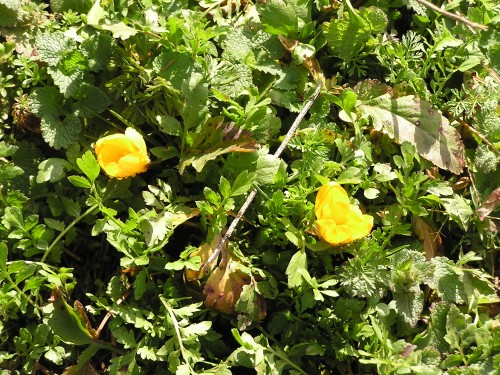
If you visit our Facebook page, you’ll even get a chance to watch some video that we took of our early spring on the farm!
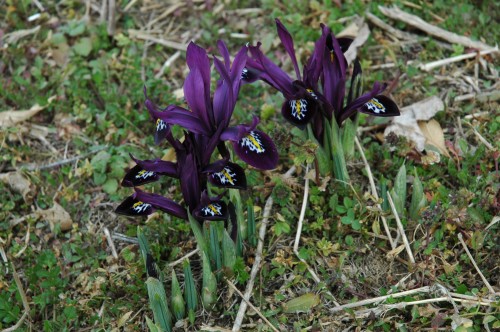
by Briscoe White | Feb 24, 2011 | Basics, Gardening, Growing, Herbs, Inspiration, Recipes |
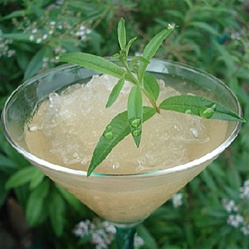
We appreciate many plants at first glance on their appearance, but the first thing you notice about Lemon Verbena is its intoxicating lemony scent. Popularized in the Victorian Era as a natural perfume and aromatic home air freshener, Lemon Verbena was considered the hottest new scent among posh socialites who would use it in finger bowls, potpourris or herb sachets that they tucked into their clothes. Ancient Greeks believed that if it was placed under their pillows, it would bring sweet dreams. Symbolizing enchantment and good fortune, Lemon Verbena has a history as sweet as its smell!
Around 1250 A.D., Incan farmers discovered that by accidentally planting a variety of Lemon Verbena near their cotton crops, that it acted as a natural insect repellent. From then on, this Argentinean native herb was grown near homes to keep pests away. Brought to Europe by the Spanish, who named the plant after the Queen of Spain in 1784, Lemon Verbena was brought to North America when pilgrims migrated to “The New World”, where it still flourishes as a perennial in zones eleven through eight, and grows as a tender perennial or annual in colder areas. (It can grow to over ten feet tall in areas with very mild winters!)
A key ingredient to many cuisines including Indian, Latin American, Mexican and French, its lemony flavor is enjoyed in everything from flakey fish dishes to desserts. It is the essential ingredient in the French tea, verveine, and can be added to greased cake pans before baking to infuse the citrus taste into desserts. A delicious digestive aid and antioxidant, Lemon Verbena is a dynamic herb with a soothing lemon scent.
by Briscoe White | Feb 24, 2011 | Basics, Containers, Gardening, Growing, Herbs, Indoor Gardening, Inspiration, Miscellaneous, Recipes |
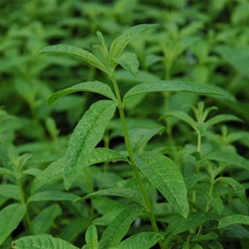
I know I say this with many herbs, but Lemon Verbena has to be one of my absolute favorites. It is easy to grow and maintain, loves living in a pot on the windowsill, and smells delightful! Lemon Verbena has a wonderful lemon flavor with no bitterness– nature’s lemon candy. Try adding a few leaves to your next cup of tea, or steep a few leaves in milk to be used in pudding or ice cream. You could even see if you can find some Lemon Verbena scented wax melts and use deluxe aroma burners to really fill your home with the scent.
Lemon Verbena likes warm, sunny conditions and well-drained soil. If kept warm inside all year, lemon verbena is an evergreen perennial; if exposed to frost, it is deciduous. Do not over-water, and prune in the fall for a bushier plant in the spring.
As previously stated, Lemon Verbena’s lovely medium-green leaves give off a light lemony scent. Before guests arrive I make sure to shake and brush the leaves around a bit, to stimulate the essential oils and really release the natural aroma of my indoor verbenas. Guests love it, especially on cold winter nights when we’re dreaming of summer lemonade and sunshine.. And might I add how much healthier it is to have fresh, all-natural, sweet-smelling herbs and flowers in your house, rather than scented candles and air fresheners? Scented candles are one of the most popular house-hold carcinogens. Plants, on the other hand, detoxify your home!

One common problem associated with Lemon Verbena is spider mites. They love the underside of the leaves. Keep an eye out for these little buggers, and if you do have a problem pick up a mild non-toxic insecticide at your favorite store. You can also companion plant herbs that are natural insecticides, like Rue, Pyrethrum and Tansy nearby to help discourage unwanted pests!
by Briscoe White | Feb 22, 2011 | Basics, Gardening, Growing, Herbs, Inspiration, Miscellaneous |
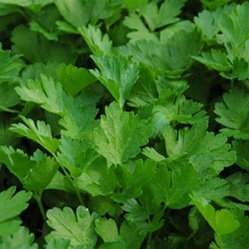
Italian Flat Leaf Parsley
Happy Parsley Day! On February 22nd, we take time to honor a much loved culinary and medicinal herb that packs a punch of flavor! An herb, a spice AND a vegetable all in one plant, this dynamic herb is a key component in many cuisines like Middle Eastern and Spanish, but is most distinctly known in Italian dishes. Parsley symbolizes love, protection and purification and throughout history has been a sign of honor and class. Ancient Greeks used Parsley to honor champions of sporting events, and it was also used in wreaths and sprinkled on the dead. The word “Parsley” is derived from the Greek word meaning “rocks or stones”, which reflects the terrain Parsley is native to. They believed that Parsley grew in the spot where the mythological hero Archemorus was slain.
The two main varieties, Italian Flat Leaf and Curly, are adored for different reasons. While some believe the Flat Leaf is easier to grow, it is the quintessential Parsley for cooking, as it has a more flavorful taste. The soft, crinkled look of the Curly Parsley makes it a great garnish and it is used to enhance many gourmet dishes with its beauty. Also a necessary component to the favorable herbal combination, Bouquet Garni, Parsley tastes terrific with hearty dishes like potatoes, stews, lamb, lasagna or rice.
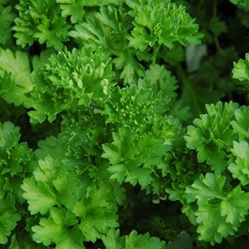
Curly Parsley
Medicinally, Parsley has a long history of being associated with women’s health. An emmenagouge, it was often used to start the menstrual cycle, but should not be consumed in great quantity by pregnant women. Parsley also contains elements that help the body absorb Manganese much more efficiently, an important mineral for strengthening bones. When paired with dishes that contain high zinc or copper-rich foods, it helps retain these bone-improving vitamins and minerals much more thoroughly. When applied directly to insect bites, it is also said to soothe the itching or stinging sensation!
A great companion plant, Parsley attracts insects, diverting their attention from other garden growers. Plant Parsley near your tomatoes to draw the attention of pesky tomato hornworms, moths and flies away from your veggies. Parsley thrives in full sun, with moist, well-drained soil, but because of its tough seed coat, it can often be hard to germinate from seed. If germination actually does occur, it should only take four to six weeks to see sprouts peeking through the soil. Superstition says that the reason that Parsley takes so long to germinate is because it has to travel to Hell and back seven times before sprouting. Though we aren’t sure where this delightful herb got such a bad rap, we assure you, it’s been growing safe and sound in our greenhouse!
by Briscoe White | Feb 18, 2011 | Gardening, Growing, Herbs, Inspiration, Life on the Farm |
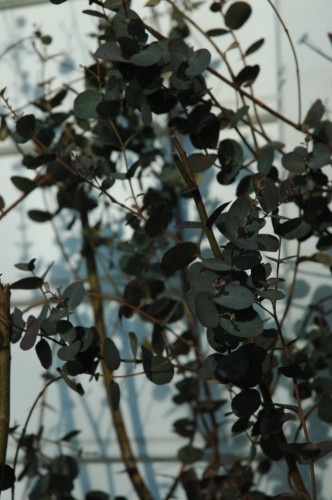
Eucalyptus plants are hardy perennials favored by many gardeners. Our favorite, the Silver Drop variety, has green leaves with a slightly dusty, or silvery, appearance. Their leaves contain highly fragrant oils, used in many medicines and perfumes. Silver Drop sprigs are a perfect addition to floral arrangements, both fresh and dried, because they hold their shape and last a long time without wilting. Considered a valuable everlasting for wreaths, crafts, and dried arrangements, its uniformly rounded leaves, erect, straight stems and elegant silvery color add depth that lasts much longer than most cut foliage.
Native to chillier zones of Tasmania, this beautiful plant is known to be remarkably cold hardy. In the states it thrives in zones 7-11 and even grows marvelously through our hot, humid summers and cold, wet winters here, in the Mid Atlantic. We can personally attest to this– we have one right here on the farm! It is in a pretty exposed area, vulnerable to harsh river winds and hard winter frosts. We’ve even over-pruned in the past few years, and this baby keeps coming back! It’s as beautiful as it is tenacious, and no matter what season, remains our most lovely landscaping shrub. We’re glad it’s here to stay.
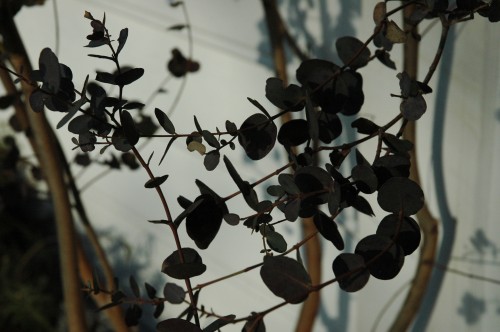
Needless to say, Eucalyptus is pretty easy to grow. Give it lots of sunshine and rich, well-drained soil. Water only when the top inch of soil feels dry to the touch. Prune in the spring, wherever you see any brown or dead foliage. And enjoy!
by Herb Exchange | Feb 15, 2011 | Inspiration, Miscellaneous, Recipes |

Chimichurri Steak
Our resident Chef and Office Manager, Julie discovered a great recipe over the weekend using fresh herbs. The fresher, the better!
There are so many herbs in our greenhouse to choose from that I can go on a culinary adventure any day of the week. On Friday, I chose to put a little Latin flair into my weekend by whipping up a delicious Argentinean chimichurri sauce with fresh ‘Italian Flat Leaf’ Parsley, ‘English’ Thyme, and ‘Greek’ Oregano that I got right here at The Growers Exchange. This recipe was super simple but packed a world of flavor when drizzled over my perfectly grilled steak!!
Chimichurri (you can use a food processor or chop by hand):
1 1/2 cup Spanish olive oil
Juice of 2 limes
1 1/2 cup finely chopped fresh ‘Italian Flat Leaf’ Parsley
8 cloves garlic, finely chopped
1 shallot, minced
1 Tbsp each finely chopped fresh ‘English’ Thyme and ‘Greek’ Oregano
Salt and pepper to taste
Instructions:
Combine the ingredients in a bowl and season with salt and pepper. Or, place the herbs, shallots and salt & pepper into a food processor. Pulse until fine, then drizzle the olive oil down the shoot while pulsing and until you get your desired texture. Divide the chimichurri between 2 bowls. Use half as the marinade and half as the dipping sauce.
Steak:
2 lb skirt steak
Chimichurri
Salt and pepper
Instructions:
1. Place the steak in a large baking dish and pour half of the chimichurri over it. Turn to coat; cover and marinate in the refrigerator for 2 hours.
2. Preheat grill to high. Let the steak come to room temperature. Remove it from the marinade and season with salt and pepper. Grill for 4 to 5 minutes on one side until browned, turn, and grill another 4 to 5 minutes for medium-rare doneness. Remove from the grill, let the meat rest for 10 minutes, and slice thinly on the bias. Serve with the remaining chimichurri on the side











